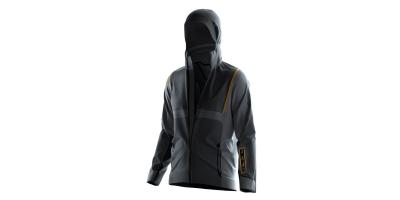The Graphene-Info weekly newsletter
Published: Tue, 05/18/21
Qurv Technologies develops graphene-enabled wide-spectrum image sensor technologies
Qurv Technologies, a Spain-based startup established in 2020 to develop wide-spectrum image sensors based on graphene and quantum-dot technologies, has developed a sensor that combines the unique electronic properties of graphene with suitable quantum nanoparticles as light sensitizers. The new device reportedly enables efficient detection of a broad range of wavelengths – from ultraviolet to infrared light – all concentrated into one simple device.
The production and transfer process of graphene leverages existing scalable Complementary Metal Oxide Semiconductor (CMOS) manufacturing processes. Furthermore, this graphene-based sensor could replace traditional costly alternatives based on indium gallium arsenide, paving the way to SWIR imagers up to 1000 times cheaper.
GMG updates on graphene aluminum-ion batteries performance
Last month, Australia-based Graphene Manufacturing Group (GMG) announced a research agreement with the University of Queensland’s Australian Institute for Bioengineering and Nanotechnology (“AIBN”) for the development of graphene aluminum-ion batteries. Now, GMG has shared the initial performance data when tested in coin cells for the patent-pending surface perforation of graphene in aluminium-ion batteries developed by the Company and the University of Queensland (“UQ”). Currently, GMG Graphene is producing coin cell prototypes for customer testing in Q4 2021.
Under the recently announced agreement, GMG will manufacture commercial battery prototypes for watches, phones, laptops, electric vehicles and grid storage with technology developed at UQ. GMG has also signed a license agreement with Uniquest, the University of Queensland commercialization company, which provides GMG an exclusive license of the technology for battery cathodes.
HydroGraph Clean Power closes private placement to fund commercialization of its proprietary hydrogen and graphene production technology
HydroGraph Clean Power, a Canada-based company that was formed to fund and commercialize green, cost-effective processes to manufacture graphene, hydrogen and other strategic materials in bulk, has announced that it has closed a private placement for gross proceeds of CAD$6,505,000 (over USD$5,372,000) led by PowerOne Capital Markets Limited and Haywood Securities. HydroGraph is in the process of pursuing a direct listing on the Canadian Securities Exchange.
The proceeds of the Financing will enable HydroGraph to commercialize its patented hydrogen and graphene manufacturing technology and market the end products. The Company is building a new commercial manufacturing facility which will be able to mass-produce HydroGraph’s competitive, high quality, green products.
Clothing brand 878 developed a graphene-enhanced smart sailing jacket
High-performance clothing brand 878 developed a new smart sailing jacket, called Project One. The jacket utilizes graphene-enhanced materials to enable high flexibility and weatherproofing while still being extremely lightweight.

The jacket also features a small flexible E Ink display produced by Plastic Logic. The display is connected to your boat's systems via Bluetooth to show navigational and other kinds of information.
Researchers design atomically precise graphene nanoribbon heterojunction sensor
An international research team, led by the University of Cologne, has succeeded in connecting several atomically precise graphene nanoribbons to form complex structures. The scientists have synthesized and spectroscopically characterized nanoribbon heterojunctions, and were able to integrate the heterojunctions into an electronic component. In this way, they have created a novel sensor that is highly sensitive to atoms and molecules.
"The graphene nanoribbon heterojunctions used to make the sensor are each seven and fourteen carbon atoms wide and about 50 nanometres long. What makes them special is that their edges are free of defects. This is why they are called "atomically precise" nanoribbons," explained Dr. Boris Senkovskiy from the Institute for Experimental Physics. The researchers connected several of these nanoribbon heterojunctions at their short ends, thus creating more complex heterostructures that act as tunneling barriers.
Tru Tension launches new spray for bikes using Applied Graphene Materials' GNPs
Applied Graphene Materials has announced that its partnership with Tru-Tension has resulted in the launch of a new detailing spray enhanced with AGM’s graphene nanoplatelet technology.

UK-based Tru-Tension designs and manufactures products for biking enthusiasts, that include tools, cleaning products, lubricants and accessories. Following in-house research and testing, the manufacturer claims that the new formulation enhanced with AGM’s industry-leading Genable® graphene dispersion technology delivers extended performance benefits.
Cardea Bio partners with Scentian Bio to create a bio-electronic tongue/nose platform
Cardea Bio, a biotech company integrating molecular biology with semiconductor electronics, has signed a commercial partnership with Scentian Bio. Scentian is an expert in synthetic insect odorant receptors (iORs), one of nature’s ways of detecting and interpreting smells.
The partnership will enable Scentian to use a customized Cardean chipset, built with graphene-based biology-gated transistors, which will allow Scentian to manufacture a bio-electronic tongue/nose tech platform.
ESA and Poland-based AGP develop a graphene-based bi-functional temperature and magnetism sensor
The European Space Agency (ESA) has announced that a project it has backed has yielded a combined temperature and magnetism sensor. “Any time we can do more with less is a good result for the space sector,” notes ESA materials specialist Ugo Lafont. “Thanks to the unique properties of graphene, our prototype bi-functional sensor can measure magnetic field strength at the same time as taking temperature readings.
 Prototypes of bi-functional sensor by ESA and AGP image
Prototypes of bi-functional sensor by ESA and AGP image
“And our tests show the sensor operates reliably from room temperature down to 12 degrees Kelvin. Normally separate temperature sensors are required to accurately measure such wide temperature ranges, right down to cryogenic levels.”





